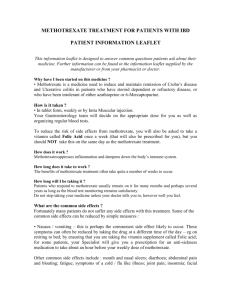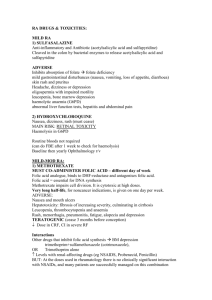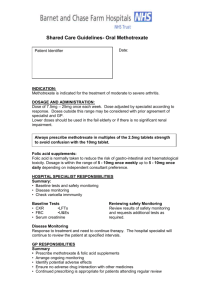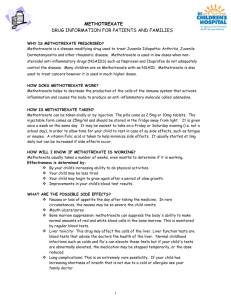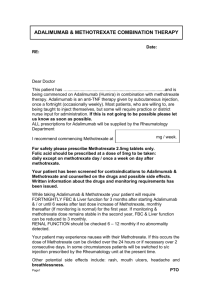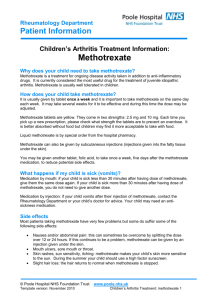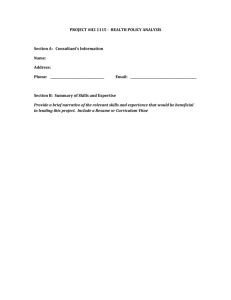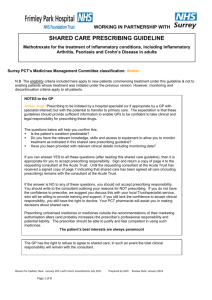METHYLPHENIDATE TABLETS (Ritalin)
advertisement
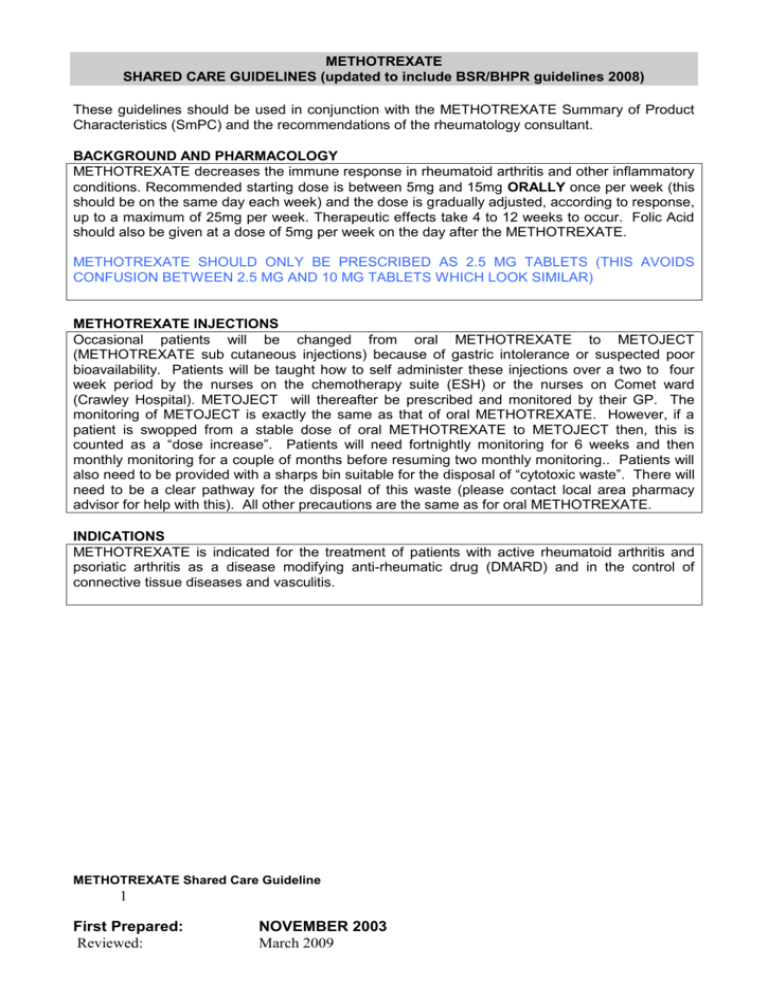
METHOTREXATE SHARED CARE GUIDELINES (updated to include BSR/BHPR guidelines 2008) These guidelines should be used in conjunction with the METHOTREXATE Summary of Product Characteristics (SmPC) and the recommendations of the rheumatology consultant. BACKGROUND AND PHARMACOLOGY METHOTREXATE decreases the immune response in rheumatoid arthritis and other inflammatory conditions. Recommended starting dose is between 5mg and 15mg ORALLY once per week (this should be on the same day each week) and the dose is gradually adjusted, according to response, up to a maximum of 25mg per week. Therapeutic effects take 4 to 12 weeks to occur. Folic Acid should also be given at a dose of 5mg per week on the day after the METHOTREXATE. METHOTREXATE SHOULD ONLY BE PRESCRIBED AS 2.5 MG TABLETS (THIS AVOIDS CONFUSION BETWEEN 2.5 MG AND 10 MG TABLETS WHICH LOOK SIMILAR) METHOTREXATE INJECTIONS Occasional patients will be changed from oral METHOTREXATE to METOJECT (METHOTREXATE sub cutaneous injections) because of gastric intolerance or suspected poor bioavailability. Patients will be taught how to self administer these injections over a two to four week period by the nurses on the chemotherapy suite (ESH) or the nurses on Comet ward (Crawley Hospital). METOJECT will thereafter be prescribed and monitored by their GP. The monitoring of METOJECT is exactly the same as that of oral METHOTREXATE. However, if a patient is swopped from a stable dose of oral METHOTREXATE to METOJECT then, this is counted as a “dose increase”. Patients will need fortnightly monitoring for 6 weeks and then monthly monitoring for a couple of months before resuming two monthly monitoring.. Patients will also need to be provided with a sharps bin suitable for the disposal of “cytotoxic waste”. There will need to be a clear pathway for the disposal of this waste (please contact local area pharmacy advisor for help with this). All other precautions are the same as for oral METHOTREXATE. INDICATIONS METHOTREXATE is indicated for the treatment of patients with active rheumatoid arthritis and psoriatic arthritis as a disease modifying anti-rheumatic drug (DMARD) and in the control of connective tissue diseases and vasculitis. METHOTREXATE Shared Care Guideline 1 First Prepared: Reviewed: NOVEMBER 2003 March 2009 AREAS OF RESPONSIBILITY GP responsibilities Consultant responsibilities 1. Initial referral to secondary care. 1. Confirmation of diagnosis. 2. To inform the consultant if unwilling to 2. Recommends appropriate therapy. enter into shared-care arrangements 3. To ensure that all newly treated patients according to the LES. (and/or their carers) receive appropriate 3. To provide prescriptions. A education and advice regarding their demonstrable system should be in place drug therapy. This should include written to ensure that prescribing is reviewed by information and the purple NPSA the GP if there is no record of the fact booklet. that monitoring has taken place within 4. To ensure and take responsibility for the agreed time scales. baseline investigations and advise on 4. To record any changes in therapy in the future problems appropriately. prescribing record on receipt of such 5. Timely communication with primary care communication from secondary care. regarding changes in therapy. 5. To monitor patients overall health and Changes of METHOTREXATE dose well-being and to report any adverse should be recorded in the purple NPSA drug reactions or interactions to booklet carried by the patient. secondary care. 6. Clinical review and to report any adverse 6. To review the appropriateness of drug reactions or interactions to primary prescribing for patients who have not care. been seen by a specialist for over 12 7. Notify the GP of the patient’s failure to months. attend for clinical review Patient responsibilities 1. To attend appointments and organize blood tests as advised. 2. To inform the GP if health problems arise 3. To be aware of side effects and report any relevant symptoms 4. To carry the purple NPSA booklet and ensure that changes of METHOTREXATE dose and dates of blood test results are entered into this. 5. To show the purple NPSA booklet to community pharmacist DOSAGE AND ADMINISTRATION Route: Oral. Tablets are swallowed whole with a glass of water Dose: 5-15 mg one day per week (AS 2.5MG TABLETS) increasing slowly to 25mg per week depending on response. INFORMATION TO PATIENTS The patient will receive a purple NPSA METHOTREXATE booklet, METHOTREXATE information leaflet from the Arthritis Research Council (via hospital clinic) and appropriate counselling. The patient will be asked to contact their GP or rheumatology consultant immediately if any of the following occur: fever, sore throat, cough, shortness of breath, diarrhoea, skin rash or mouth ulcers, unexplained bruising or bleeding. BASELINE DATA AND ROUTINE MONITORING Monitoring criteria Before Treatment Responsibility : CONSULTANT Exclude pregnancy Liver Function Tests (LFTs) (including AST / ALT) METHOTREXATE Shared Care Guideline 2 First Prepared: Reviewed: NOVEMBER 2003 March 2009 Chest X-ray Full blood count U & Es First few months of treatment Every TWO weeks : Full blood count, U&E, LFTs Until 6 weeks after last dose increase, thereafter once every two months ESR/CRP, U&E, LFT & FBC if no problems. The prescribing doctor will stop METHOTREXATE treatment (and discuss with Rheumatologist) if any of the following occur: White blood cell count < 3.5x 109/l Neutrophils < 2 x 109/l Platelets < 150 x 109/l AST / ALT > 2 times upper limit normal range Albumin – unexpected fall in the absence of active disease Rash or oral ulceration, nausea and vomiting, diarrhoea New or increasing dyspnoea or dry cough MCV > 105 fl (check B12, folate, TSH) Mild to moderate renal impairment Severe sore throat, abnormal bruising (check immediate FBC) ADVERSE EFFECTS – see Statement of Product Characteristics for details: Photosensitivity, marrow suppression, GI disturbances, hepatic fibrosis, infertility, teratogenicity, pulmonary toxicity, renal failure (rare). Patients with known allergy to Methotrexate should not receive the drug CONTRA-INDICATIONS The drug is teratogenic and both men and women must take contraceptive precautions during treatment and for 3-6 months after stopping. It must be avoided whilst breast feeding. It may reduce male fertility. DRUG INTERACTIONS – see Statement of Product Characteristics for details Avoid folate antagonist drugs especially Cotrimoxazole and Trimethoprim. NSAID’s and aspirin used concurrently are not contraindicated but may increase toxicity. Alcohol should be reduced to three units per week during treatment with METHOTREXATE VACCINATION ADVICE 1. Patients receiving METHOTREXATE must not receive immunizations with live vaccines. Inactivated polio is available although suboptimal response may be seen. 2. Pneumovax and annual flu vaccine is recommended 3. In patients receiving METHOTREXATE exposed to chicken pox or shingles (who have not had prior exposure to these viruses), passive immunisation should be carried out using VZIG. The Herpes Zoster immunoglobulins can be obtained from the Health Protection Agency tel: 020 8200 6868 INFORMATION TO BE RECEIVED BY THE GP FROM THE CONSULTANT METHOTREXATE Shared Care Guideline 3 First Prepared: Reviewed: NOVEMBER 2003 March 2009 The consultant’s review letter will be sent after initial assessment and following each further appointment. If a GP needs to contact the Consultant for advice about a patient’s METHOTREXATE the call should be returned whenever possible within 24 hours. INFORMATION TO BE RECEIVED BY THE CONSULTANT FROM THE GP Recent NPSA guidance suggests shared care between specialist clinic and GP. In the rare event that the GP is unwilling to assume prescribing responsibility for the patient the consultant should be informed within 1 week of receipt of the consultant’s letter. In such cases the GP must inform the consultant of all relevant medical information regarding the patient and any changes to the patient’s medication regime irrespective of indication. THE GP SHOULD INFORM THE CONSULTANT OF ANY ADVERSE EFFECTS EXPERIENCED BY THE PATIENT. LIKEWISE THE CONSULTANT SHOULD INFORM THE GP OF ANY ADVERSE EFFECTS EXPERIENCED BY THE PATIENT. CONTACT NAMES AND DETAILS: Dr Raad Makadsi, Consultant Rheumatologist, Crawley & East Surrey Hospitals, ext 3672/6853 Dr Warren Shattles, Consultant Rheumatologist, Crawley & East Surrey Hospitals ext 3672/6853 Dr Ursula Davies, Consultant Rheumatologist, East Surrey Hospital ext 1798 Dr Sian Griffith, Consultant Rheumatologist, East Surrey Hospital ext 6748 Lynda Martin, Rheumatology Nurse Specialist, Crawley Hospital ext 3097 Support groups and information websites Arthritis Research Campaign www.arc.org.uk Arthritis Care www.arthritiscare.org.uk NRAS www.rheumatoid.org.uk BSR www.rheumatology.org.uk Approved by Dr Patrick Kerr Clinical Governance East Surrey PCT cluster Date of guidance 31.3.09 Date Reviewed: 10 January 2011 METHOTREXATE Shared Care Guideline 4 First Prepared: Reviewed: NOVEMBER 2003 March 2009 Dr Sian Griffith Consultant Rheumatologist
